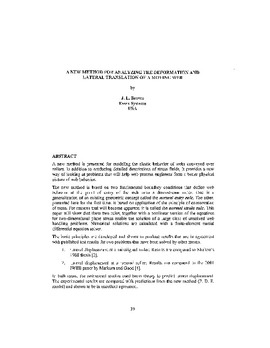| dc.contributor.author | Brown, J. L. | |
| dc.contributor.other | International Conference on Web Handling (2005) | |
| dc.date.accessioned | 2019-11-08T22:57:06Z | |
| dc.date.available | 2019-11-08T22:57:06Z | |
| dc.date.issued | 2005-06 | |
| dc.identifier | oksd_icwh_2005_brown2 | |
| dc.identifier.citation | Brown, J. L. (2005, June). A new method for analyzing the deformation and lateral translation of a moving web. Paper presented at the Eighth International Conference on Web Handling (IWEB), Stillwater, OK. | |
| dc.identifier.uri | https://hdl.handle.net/11244/321906 | |
| dc.description.abstract | A new method is presented for modeling the elastic behavior of webs conveyed over rollers. In addition to producing detailed descriptions of stress fields, it provides a new way of looking at problems that will help web process engineers form a better physical picture of web behavior. | |
| dc.description.abstract | The new method is based on two fundamental boundary conditions that define web behavior at the point of entry of the web onto a downstream roller. One is a generalization of an existing geometric concept called the normal entry rule. The other, presented here for the first time, is based on application of the principle of conservation of mass. For reasons that will become apparent, it is called the normal strain rule. This paper will show that these two rules, together with a nonlinear version of the equations for two-dimensional plane stress enable the solution of a large class of unsolved web handling problems. Numerical solutions are calculated with a finite-element partial differential equation solver. | |
| dc.description.abstract | The basic principles are developed and shown to produce results that are in agreement with published test results for two problems that have been solved by other means. | |
| dc.description.abstract | 1. Lateral displacement at a misaligned roller: Results are compared to Shelton's 1968 thesis [2]. | |
| dc.description.abstract | 2. Lateral displacement at a tapered roller: Results are compared to the 2001 IWEB paper by Markum and Good [4]. | |
| dc.description.abstract | In both cases, the referenced studies used beam theory to predict lateral displacement. The experimental results are compared with predictions from the new method (P. D. E. model) and shown to be in excellent agreement. | |
| dc.description.abstract | Following a brief summary of the background of the problem, the new boundary condition is derived and other relevant equations summarized. Results are then computed and compared with results for the two cases mentioned above. | |
| dc.format | application/pdf | |
| dc.language | en_US | |
| dc.publisher | Oklahoma State University | |
| dc.rights | In the Oklahoma State University Library's institutional repository this paper is made available through the open access principles and the terms of agreement/consent between the author(s) and the publisher. The permission policy on the use, reproduction or distribution of the article falls under fair use for educational, scholarship, and research purposes. Contact Digital Resources and Discovery Services at lib-dls@okstate.edu or 405-744-9161 for further information. | |
| dc.title | New method for analyzing the deformation and lateral translation of a moving web | |
| osu.filename | oksd_icwh_2005_brown2.pdf | |
| dc.type.genre | Conference proceedings | |
| dc.type.material | Text | |
